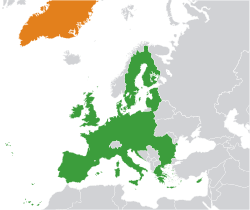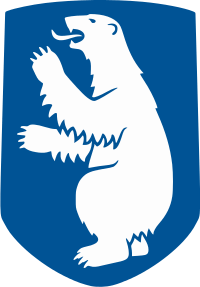Greenland–European Union relations
 |
|
European Union |
Greenland |
|---|---|
 |
| This article is part of a series on the politics and government of Greenland |
|
|
|
|
Greenland, an autonomous constituent country of the Kingdom of Denmark (which also includes the countries of Denmark and Faroe Islands) is one of the EU's overseas countries and territories (OCT). Greenland receives funding from the EU for sustainable development and has signed agreements increasing cooperation with the EU.
Trade
In 2010, Greenland's exports to the EU amounted to €331 million (a 92.7% share of Greenland's total exports) and Greenland's imports from the EU were valued at €614 million (68.9% of all Greenland's imports). Exports to the EU were mainly food and live animals (89%). Imports from the EU included mineral fuels, lubricants (and related goods), machinery and transport equipment (together 47%). The EU is Greenland's main trading partner. However, Greenland ranks as the EU's 103rd largest trading partner.[1]
In 2009 the EU put in place an import ban on seal fur on grounds on animal cruelty, but made exemptions for Inuit communities in Greenland and Canada in order to protect their way of life. The ban only allows small scale hunts for population control and local circulation – produce is not allowed to enter the EU. The ban angered those communities in the Arctic Circle who depend on sales from large scale seal hunting.[2][3]
OCT status
Greenland is one of the Overseas Countries and Territories (OCT) of the EU because of its political union with Denmark. As a result, Greenland has some integration with the EU's internal market via association agreements. It is also within the EU's common external tariff but they may charge customs in a non-discriminatory manner. Greenlandic citizens have EU citizenship.[4] OCT nationals can be granted the right to vote for and participate in the election of the European Parliament, subject to the conditions defined by the related member states in compliance with Community law.[5]
Up to 2006, all EU funds to Greenland (then €42.8 million per year) went via the EU–Greenland fishing agreement. Between 2007 and 2013, the EU provided €25 million per year outside of fishing.[6] It has been given aid since it pulled out of the EU (see below) in 1985 to roughly the same amount it was previously receiving in EU structural funds (which it lost the right to receive due to its secession). This amounted to about 7% of Greenland's budget. The amount paid via the fishing agreement was in return for EU vessels fishing in Greenland's waters and to help restructure Greenland's fishing fleet. However, this deal was struck down by the European Court of Auditors, who felt the amount the EU was paying was too high for the quantity of fish caught.[7]
Outside the EU
Greenland originally joined the then-European Communities with Denmark in 1973. At that time Greenland had no autonomy from Denmark, which it gained 1979. Greenland got some exceptions like about restrictions on business for non-residents, and about fisheries.[8]
Greenland left in 1985, following a referendum in 1982 with 53% voting for withdrawal after a dispute over fishing rights.[9] The Greenland Treaty formalized their exit.
There has been some speculation as to whether Greenland may consider rejoining the European Union, although this seems highly unlikely to occur any time soon. On 4 January 2007, the Danish daily Jyllands-Posten quoted the former Danish minister for Greenland, Tom Høyem, as saying "I would not be surprised if Greenland again becomes a member of the EU ... The EU needs the Arctic window and Greenland cannot alone manage the gigantic Arctic possibilities".[10] The debate has been reignited[11] in light of the 2008–2011 Icelandic financial crisis. The EU Common Fisheries Policy is an important reason why Greenland, Norway and Iceland stay outside the EU. There was hope that the Icelandic negotiations on EU membership 2011–2013 could create an exception to the policy but the negotiations never got that far. "Gigantic Arctic possibilities" refers to natural resoruces such as mining. There is a very large iron deposit, Isua Iron Mine. Greenland can not finance the large cost of developing it and does not have such experience, so it has contracted a foreign company, which did not start to develop it because of low iron prices.
EU–Greenland partnership
Greenland is eligible for EU funding. Between 2007 and 2013, the EU allocated approximately €190 million, and between 2014 and 2020, €217.8 million are planned for sustainable development, with focus on education.[12] In 2015, a joint declaration about closer relations between EU and Greenland was signed by Denmark, Greenland and the EU.[13]
The Brexit debate has reignited talk about the EU in Greenland, and there have been calls for the island to rejoin the Union.[14]
See also
| Wikisource has original text related to this article: |
- Denmark and the European Union
- Foreign relations of Greenland
- Accession of Iceland to the European Union
- Enlargement of the European Union
- Representation of Greenland, Brussels
- Greenland (European Parliament constituency)
- Greenlandic European Economic Community membership referendum, 1982
- Norway–European Union relations
References
- ↑ EU BILATERAL TRADE AND TRADE WITH THE WORLD (PDF), European Commission
- ↑ Arctic communities angered by EU seal product ban Copenhagen Post 2009
- ↑ EU takes aim at Canada, bans seal products, Guardian 2009
- ↑ Article 17 of European Union Treaty as of 1999
- ↑ Green paper on future relations between EU and overseas countries/territories, 3. 1. 1. http://ec.europa.eu/development/icenter/repository/1_EN_ACT_part1_v8.pdf
- ↑ EU Relations with Greenland, EEAS
- ↑ A new deal for Greenland and the EU?, EFC
- ↑ Lov om Danmarks tiltrædelse af De europæiske Fællesskaber Bilag 1 til loven: Akt vedrørende tiltrædelsesvilkårene og tilpasningerne af traktaterne Protokoller til Tiltrædelsesakten Protokol nr. 4 om Grønland (Danish)
- ↑ European Commission (2005-11-10). "1985". The History of the European Union. Retrieved 2006-01-18.
- ↑ "Greenland could re-join the EU". EUobserver Review. 2007-01-05. Archived from the original on January 20, 2008. Retrieved 2007-06-25.
- ↑ EU membership debate, Sermitsiaq
- ↑ http://europa.eu/rapid/press-release_IP-14-1207_en.htm
- ↑ https://ec.europa.eu/europeaid/sites/devco/files/signed-joint-declaration-eu-greenland-denmark_en.pdf
- ↑ http://www.politico.eu/article/greenland-exit-warning-to-britain-brexit-eu-referendum-europe-vote-news-denmark/
